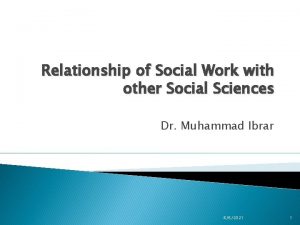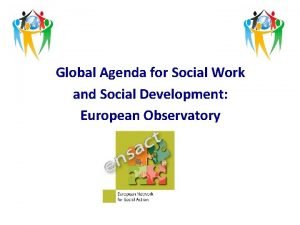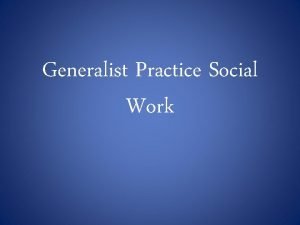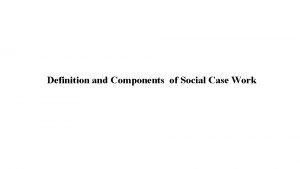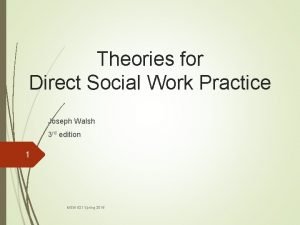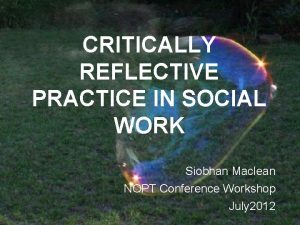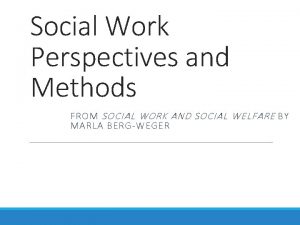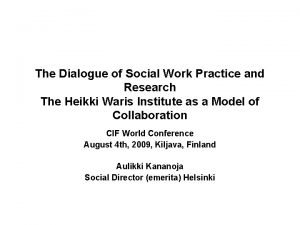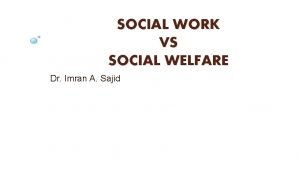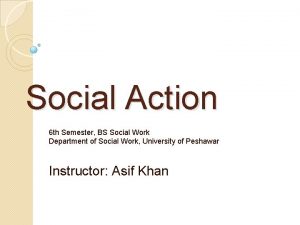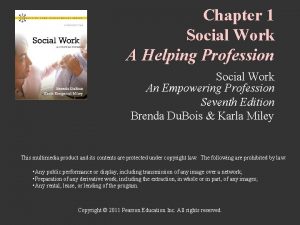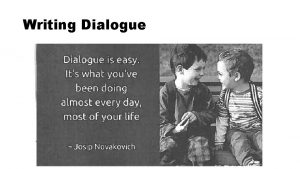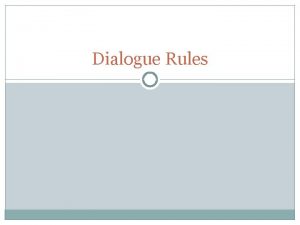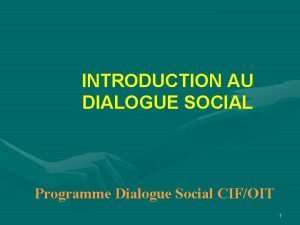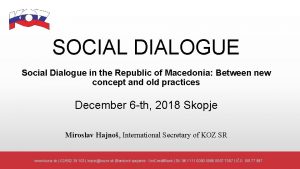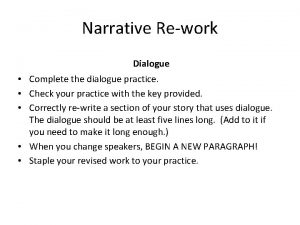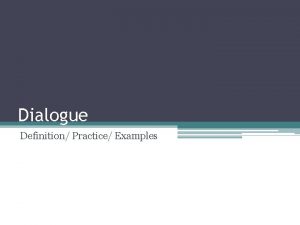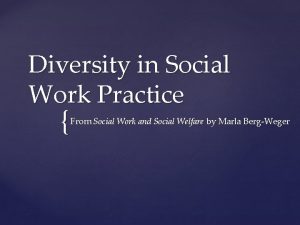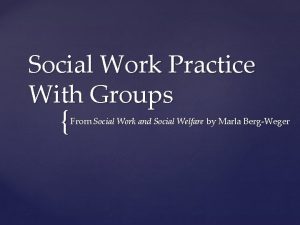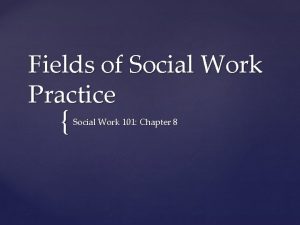The Dialogue of Social Work Practice and Research



















- Slides: 19

The Dialogue of Social Work Practice and Research The Heikki Waris Institute as a Model of Collaboration CIF World Conference August 4 th, 2009, Kiljava, Finland Aulikki Kananoja Social Director (emerita) Helsinki

The Approach of the Presentation • The practice of social work and social services as an actor in practice research • The environment of the collaboration of practice and research: Social Services Department of the City of Helsinki • The actors: Social Services Department of the city and The University of Helsinki, Institute of Social Policy 2

Basic Questions • How practice research can be organized and administered in the framework of municipal social services? • How to facilitate a dialogue between different cultures and functions of social work practice, education and research? 3

Some Historical Developments • Social Work education as a Master’s level university education started in Finland in 1970’s • Master’s degree became a qualification for social work in 1980’s • Traditionally, social work practice was seen as an applier of research results, having no position in knowledge production • During 1980’, several national plans and efforts to strengthen collaboration of social work practice and research were made, in order to develop social work’s function also as a producer of knowledge • Practical steps in organizing practice research between municipalities and universities were slow. (Opetusosiaalikeskustoimikunnan mietintö 1990, Sosiaalihuollon palvelurakenteen ja …. 1989) 4

An Early Experiment in Helsinki (1) • A project of the Social Services Dept. of the city and the University of Helsinki, 1986 – 1989 • Theme: Social Work Practice as a Producer of Knowledge: what kind of knowledge the practice of social work produces from the social conditions and living environments of families using services and benefits of municipal social service offices? (Rajavaara 1989, Rajavaara & Sirviö 1991) 5

An Early Experiment in Helsinki (2) The Structure of the Project • Six social workers in two social offices were elected to function as research social workers; they were employed and paid by the municipality • 1/3 of working hours was allocated to research function and 2/3 to regular social work practice with clients • The principal researcher came from the University, she was supervising the research work of social workers and collecting and analyzing the data in collaboration with research social workers • The supervision of the project was carried in collaboration by a steering group representing both the social service administration and the university 6

An Early Experiment in Helsinki (3) The Target Group of the Research • 28 families with children, having several years history as service users, either as clients in child protection or as recipients of social assistance • The research social workers had worked with the same families previously, as their social workers • Users’ permission was required, and interviews were taped (Rajavaara 1989, Rajavaara & Sirviö 1991) 7

An Early Experiment in Helsinki (4) Experiences and Learnings seen by the Researcher • The model offers an opportunity to produce contextrelated knowledge, not reached by academic research or by administrative information • Knowledge production becomes a shared experience by researchers and practitioners • The model contributes to immediate use of knowledge • The model strengthens social workers’ ability to think reflectively • The model strengthens social workers’ research skills and their capacity to evaluate research results (Rajavaara 1989) 8

An Early Experiment in Helsinki (5) Experiences seen by Social Service Administration • The model demonstrated the importance of commitment of the entire setting in taking the role of knowledge producer and the role as an actor in practice research • Attitudes of fellow workers and commitment of the immediate management in facilitating and contributing practice research are of utmost importance • Proportions of research and practice in work load need thorough assessment; immediate needs of practice may override research, which requires time also for thinking, dialogue and reading scientific litterature • Service users were highly interested in research and willing to participate and contribute; research orientation was seen positive and encouraging by them • Social workers received much more information of their previous clients’ living conditions, social experiences and social relations than they had received in their bureaucratic roles. 9

The New Phase of Practice Research in Helsinki After a thorough collaborative planning • The City of Helsinki and the University of Helsinki made in 2001 a contract on a common unit for collaboration of practice and research in social work, called the Heikki Waris Institute • An equivalent Swedish unit, the Mathilda Wrede Institute, was also established to serve Swedish social work practice, education and research. 10

Organization of the Heikki Waris Institute ( 1) • The institute is administratively connected with the Social Services Department of the City, the unit of development (first with one social service office, but this turned out to be difficult to administer) • The budget is included in the budget of the Soicial Services Dept. • From 2010, the institute will become a part of larger metropolitan competence centre for social service development • Collaborators are other metropolitan cities, Polytechnic and Kalliola Settlement working in the metropolitan area. 11

The Heikki Waris Institute ( 2) Staff • A director, common with the competence centre, elected by the city after consultations with the university and collaborators, paid by the city • A professor in practice research provided by the university and financed partly by the collaborative cities; researcher from the Polytechnic • A lecturer of social work, provided by the university • 5 – 10 research and development social workers, depending on the nature of projects and financial resources; elected on the basis of applications from practice, working for 2 - 3 years in the institute • One office assistant 12

The Heikki Waris Institute (3) Functions • Projects for methodological development in social work and social services; in the framework of projects, service users are participants and collaborators in the methodological development • Research projects related to evaluation of social work and social services • Consultations in research issues to participating cities, by the professor in practice research • Educational unit Praxis, where the lecturer of social work is connected with a social service office, participating in, studying and analyzing learning processes of social work, in a real field work setting • Networks of research and development social workers and practitioners from the field, educational meetings and mutual exchange of experiences 13

The Heikki Waris Institute ( 4) The Focus of Practice Research • Original focus defined in the contract between the city and the university: social work with urban social problems • Special focus: social work with families and children, methods in the process of child protection • Direct work with children and youth in the framework of social welfare offices • Problems related to social exclusion 14

The Heikki Waris Institute (5) Examples of Methodological Developments • Methods of positive discrimination in deprived areas of Helsinki, focus in work with children and families • Social work methods in direct work with children in child protection processes • Group work with young boys growing in risk zones • Group work with girls having history of institutional placements or heavy child protection measures • Social reporting as a model of knowledge production • Methods of social change work: an alternative approach with adult people having severe social problems (Tapola-Tuohikumpu 2005, Ervast & Tulensalo 2006, Heikkinen & Levamo & Parviainen & Savolainen 2007, Hussi 2005, Koskinen 2007) 15

Knowledge Production Through Practice Research: An Example (1) • • • Construction of a new approach in a situation, where social services organization was under reorganization and questions related to effects of social work were raised both inside and outside the profession Actors: one research social worker ( connected with the Heikki Waris Institute) and group of practicing social workers from adult services of Social Services Dept. ; users as collaborators in experimental construction of new approaches Functions in the knowledge production: – Making practices transparent – Identifying essential elements of working processes in the direct work with users (in the experiment the process was developed reflectively, not based on ready made theories) – Constructing regularities (”laws”) of the essential elements and identifying those ” laws” that could be transferred into other contexts in social services ( Koskinen 2007) 16

Knowledge Production Through Practice Research: An Example (2) • The process of practice research itself was also studied: how the process of practice research itself can be described? • The research social worker – together with social workers participating in the process – developed a model of practice research process, where cycles of direct social work with clients, dialogue in the development group ( analysis, reflection, testing adopted approaches, theorizing) and conceptualizing observations through writing were alternating in turns. • Drawing conclusions: What kind of results and effects the practice research process produced? The experiment produced a cyclic model of practice research. (Koskinen 2007) 17

Summary of Different Approaches applied in Helsinki: • A practice-connected practice research model in a real social service setting: research social worker’s shared work load between practice and research • A research-connected practice-research model: a research project in a special research unit, where new methods are developed in partnership with ”real” service users; research and practice overlap each other and proceed simultaneously • A ”cyclic” model, where periods of practice and research – analyzing, conceptualizing, theorizing are alternating in turns in research social workers functioning. • A model, where several approaches are combined. 18

References Ervast, Sari-Anne & Tulensalo, Hanna (2006) Sosiaalityötä lapsen kanssa. Kokemuksia lapsikeskeisen tilannearvion kehittämisestä. SOCCAn ja Heikki Waris Instituutin julkaisusarja 8/2006. Helsinki. Heikkinen, Alpo (2006) ”Olenko mä sitä riskiryhmää? ” Lastensuojelun poikaryhmien hyvinvoinnin muutostekijät – realistinen etnografia. Lapsi- ja nuorisososiaalityön erikoistumiskoulutuksen lisensiaatintutkimus. Helsingin yliopisto. Yhteiskuntapolitiikan laitos. Heikkinen, Alpo & Levamo, Pauliina & Parviainen, Maaret & Savolainen, Alli (2007) Näe minut – kuule minua. Kokemuksia ryhmistä. SOCCAn ja Heikki Waris Instituutin julkaisusarja 11/2007. Helsinki. Hussi, Taina (2005) Sosiaalinen raportointi tiedon rakentajana - menetelmäkuvaus ja käytännön kokemukset. SOCCAn ja Heikki Waris Instituutin julkaisusarja 4/2005. Helsinki. Koskinen, Anna-Kaisa ( 2007) ”Vaihtoehtoinen tarina”. Mitä on sosiaalinen muutostyö? SOCCAn ja Heikki Waris Instituutin julkaisusarja 14/2007. Helsinki. Opetussosiaalikeskustoimikunnan mietintö (1990) Sosiaali- ja terveysministeriö. Komiteanmietintö 1990: 48. Rajavaara, Marketta (1989) Tutkiva ote sosiaalityöhön? Helsingin kaupunki. Sosiaaliviraston julkaisusarja A 1/1989. Rajavaara, Marketta & Sirviö, Arno (toim. ) ( 1991) Projektitutkimus sosiaalityössä. ”Käytännön sosiaalityö tiedontuottajana” – tutkimusprojektin arviointiraportti. Helsingin kaupunki. Sosiaaliviraston julkaisusarja A 9/1991. Sosiaalihuollon palvelurakenteen ja asiantuntemuksen kehittämistä selvittänyt työryhmä (1989) Sosiaali- ja terveysministeriö. Työryhmämietintö 1989: 10. Tapola-Tuohikumpu, Sirpa (2005) Positiivisella diskriminaatiolla varhaista tukea. Helsingin kaupungin sosiaaliviraston Positiivisen diskriminaation hankekokonaisuuden ( 2001 – 2004) loppuarviointi. SOCCAn ja Heikki Waris Instituutin julkaisusarja 3/2005. Helsinki. 19
 Example dialogue congratulations
Example dialogue congratulations Social work and other social sciences
Social work and other social sciences Global agenda for social work and social development
Global agenda for social work and social development Generalist intervention model example
Generalist intervention model example Case work definition
Case work definition Theories for direct social work practice
Theories for direct social work practice Weather model social work
Weather model social work Define policy practice
Define policy practice Berg-weger practice of generalist social work download
Berg-weger practice of generalist social work download Model of group work
Model of group work Dialogue between social worker and client example
Dialogue between social worker and client example Social welfare vs social work
Social welfare vs social work Principles of social action in social work
Principles of social action in social work Social work: an empowering profession 9th edition chapter 1
Social work: an empowering profession 9th edition chapter 1 Social thinking adalah
Social thinking adalah Social thinking social influence social relations
Social thinking social influence social relations Chapter 4 work and energy section 1 work and machines
Chapter 4 work and energy section 1 work and machines Practice assessor and practice supervisor
Practice assessor and practice supervisor Hình ảnh bộ gõ cơ thể búng tay
Hình ảnh bộ gõ cơ thể búng tay Frameset trong html5
Frameset trong html5

